
Pavo is an intriguing constellation in the expansive southern sky and takes its name from the Latin reference to “peacock.”
This constellation first appeared on a 35-cm (14 in) diameter celestial globe produced in 1598 by the highly skilled cartographers Plancius and Jodocus Hondius in Amsterdam.
Petrus Plancius introduced the constellation based on observations of Dutch navigators Frederick de Houtman and Pieter Dirkszoon Keyser in the late 16th century. Johann Bayer’s Uranometria, a star atlas published in Augsburg in 1603, was the first to include Pavo.
A part of the constellation is called the Saucepan in Australia and it works as a guide to finding the south (but more on that below).
Pavo Overview & Facts
The International Astronomical Union (IAU) currently recognizes 88 constellations, which together cover the celestial sphere.
Pavo constellation ranks 44th on the IAU list in terms of size, covering 378 square degrees area or about 0.916% of the night sky.
The International Astronomical Union (IAU) chose the three-letter abbreviation Pav in 1922. (Pavo constellation is pronounced as: PAY-voh). Also, Pavonis (pronounced: PAY-voh-nis) is the genitive form of Pavo used in star names.
Alpha Pavonis, also known as the “Peacock” and appearing as a blue-white 1.91-magnitude star, is the brightest star in Pavo.
A Sun-like star Delta Pavonis is close by and 19.9 light years away.
Some interesting deep-sky objects in Pavo include NGC 6752, the third-brightest globular cluster in the sky, NGC 6872 (also known as the Condor Galaxy), and IC 4970, an unbarred lenticular galaxy, among many others.
The constellation was first mentioned in Uranometria by Johann Bayer in 1603.
Pavo is part of the “Johann Bayer” constellation family that includes: Apus, Chamaeleon, Dorado, Grus, Hydrus, Indus, Musca, Phoenix, Tucana, and Volans.
The Delta Pavonids is the only meteor shower connected to the constellation.
Six star systems in Pavo are home to planets, including HD 181433, which has a super-earth, and HD 172555, which has signs of a significant recent interplanetary collision. (Even Professor Colan in Transformers 2: Revenge of the Fallen would be impressed with this!)
You can view Pavo from latitudes between +30° and -90° in the southern hemisphere’s fourth quadrant. Pavo is in right ascension at 18h 10.4m to 21h 32.4m and in declination at −56° 35.4′ to −74° 58.8′.
Notably, a part of the constellation is popularly called “Saucepan” in Australia because it resembles the shape of a bowl-and-handle.
The Saucepan is quite easy to spot because it is large, visible, and bright throughout the year, which makes it an ideal place to begin stargazing. It is often used as a guide to finding the south.
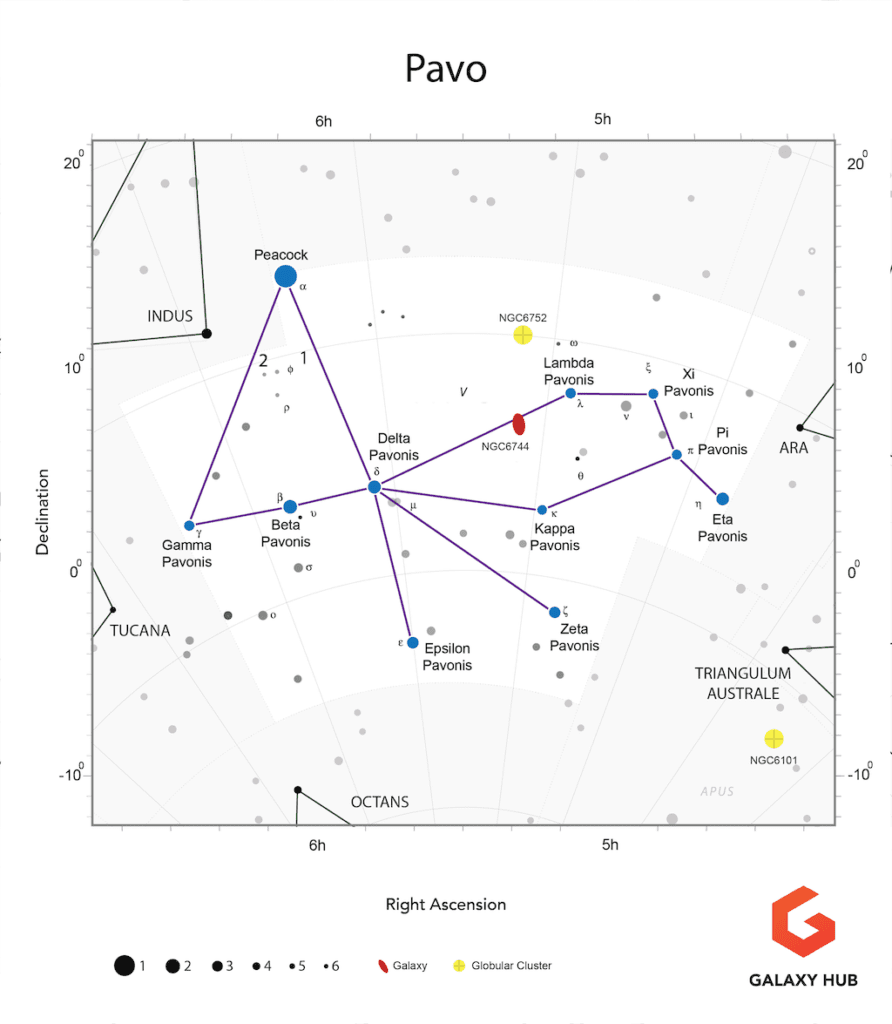
Pavo in Mythology Gamma Pavonis (γ Pavoni)
The Latin word for “peacock” is Pavo.
The constellation is assumed to represent the Java green peacock that Dutch explorers saw when sailing to the East Indies.
Peacocks had a role in several mythologies in their native India. It is a symbol of worship in Hindu mythology as a representation of the Sun. Numerous war gods of the Hindu religion, such as Brahma, Kama, and Kartikeya, rode on peacocks.
Further east in China, the peacock is a favorable omen, revered for staving off evil spirits.
The peacock was considered a sacred bird in Greek mythology, where they flew through the skies pulling Hera’s chariot.
Hera was the wife of Zeus, the ruler of all the gods on Mount Olympus. She was the goddess of the stars and the heavens. But Zeus’ wandering eye had long been a source of contention for her.
Zeus soon developed a fascination with Io, the princess of Argus. To hide Io from Hera, he turned her into a heifer. But Hera asked for the heifer as a gift and put Io under the protection of Argos Panoptis, a big giant with one hundred eyes who served as Hera’s bodyguard.
Zeus commanded Hermes to free Io and kill Argus, so he could take the nymph and possess her. When Hermes killed him, Hera lamented the loss of Argus and honored him for his dedication by placing the 100-eyed giant Argus’ eyes on her sacred animal, the peacock’s tail.
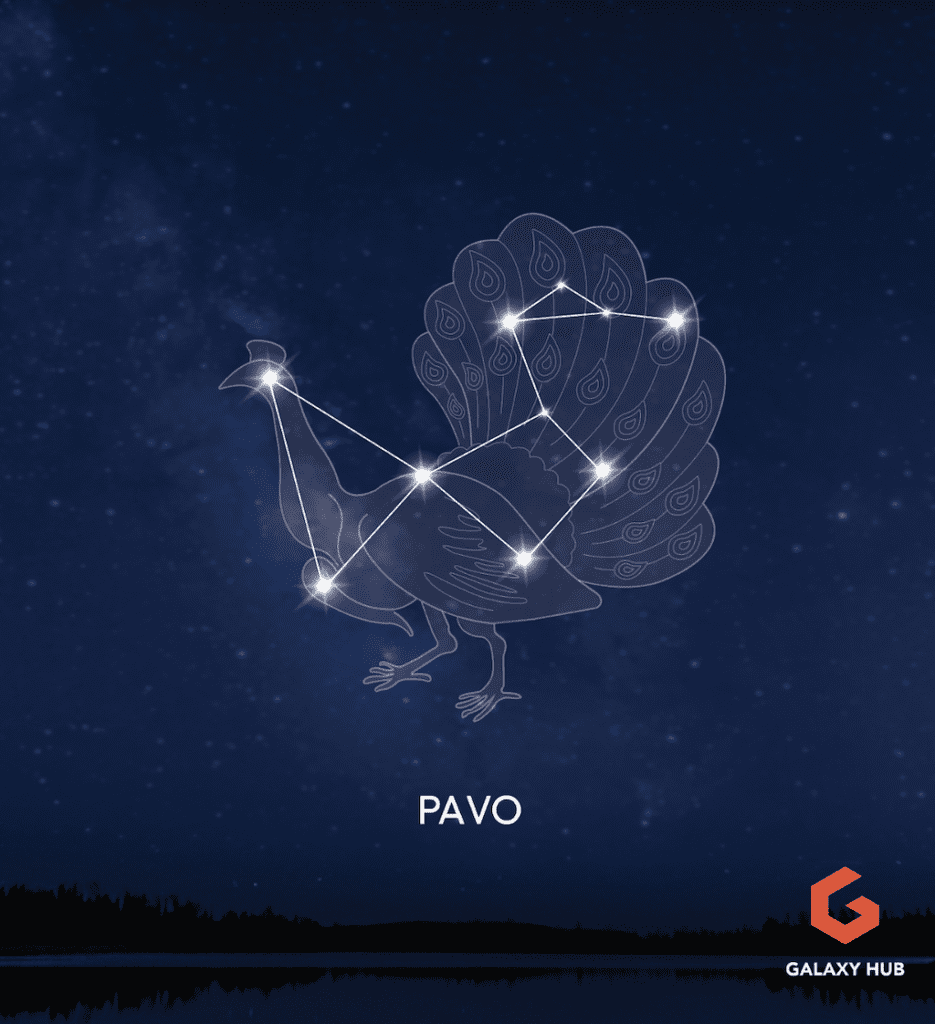
Best time of the year to view
The peacock constellation Pavo is found in the southern hemisphere of the night sky and can be viewed year-round.
During August, visibility is best at 21:00 (9 PM) and is visible at latitudes south of Pavo between +30° and -90°.
Alpha Pavonis, which has a magnitude of 1.94, is the brightest star in this constellation; the remaining stars are all no brighter than magnitude 4.0. Pavo is visible between Ara, Apus, Octans, and Indus constellations.
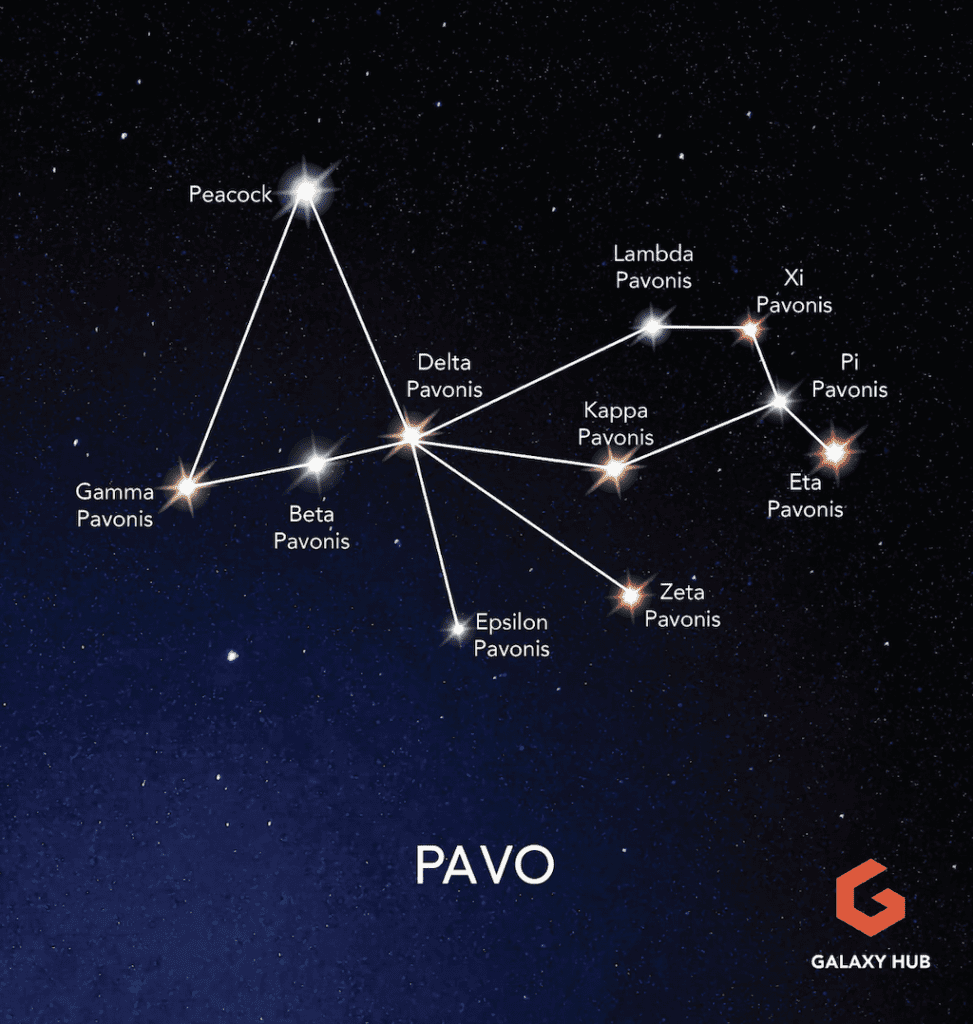
The Stars of Pavo
Peacock – Alpha Pavonis (α Pavonis)
- Distance from the earth – 179 light-years
- Magnitude -1.94
- Size – 6 x SUN
- Type of star – B3 V, the brightest star in Pavo
Compared to the SUN, the mass and radius of Alpha Pavonis are said to be six times more. But its brightness is 2,200 times more.
Her Majesty’s Nautical Almanac Office (HMNAO) called the star “peacock” in the late 1930s. HMNAO produces astronomical data and issues the Nautical Almanac under the umbrella of the United Kingdom Hydrographic Office.
When they built the Air Almanac, a navigational aid for the Royal Air Force (RAF) containing 57 brilliant stars, they gave Alpha Pavonis the moniker Peacock.
Only two of them (Alpha Pavonis and Epsilon Carinae in the constellation Carina) lacked proper names at the time. Alpha Pavonis was given the name peacock in honor of the constellation. Epsilon Carinae got the name Avior because the RAF requested that every star in the almanac have a name.
Beta Pavonis (β Pavonis)
- Distance from the earth – 137 light-years
- Magnitude – 3.42
- Size – 2.3 x SUN
- Type of star – A5IV, subgiant
The second brightest star in the constellation is Beta Pavonis.
It is an evolving subgiant star with a stellar classification type A5IV. The star is approximately 305 million years of age. and emits light from its photosphere that is 66 times brighter than the SUN.
Delta Pavonis (δ Pavonis)
- Distance from the earth – 19.89 light-years
- Magnitude – 3.56
- Size – 1.2 x SUN
- Type of star – G8 IV, subgiant
Delta Pavonis, Latinized version from δ Pavonis, is a lone circumpolar star. Without binoculars, Delta Pavonis is visible in the southern hemisphere. The subgiant star Delta Pavonis has the stellar designation G8 IV.
Delta Pavonis luminosity exceeds that of the sun by 24%, but its mass is only 105%, and its radius is 120% that of the sun. It’s said to be anywhere between 6.6 and 6.9 billion years old.
There is a higher chance that Delta Pavonis contains planets because research has linked the presence of a planetary system to a star’s abundance of heavy elements.
Maggie Turnbull and Jill Tarter of the SETI Institute (Search for Extraterrestrial Intelligence), chose Delta Pavonis as the “Best SETI target” out of the 100 closest G-class stars. Delta Pavonis is the closest star to the SUN.
Eta Pavonis (η Pavonis)
- Distance from the earth – 350 light-years
- Magnitude – 3.61
- Size – 33.5 x SUN
- Type of star – K2II, luminous giant
Eta Pavonis is a Latinized version of η Pavonis, a lone star in the southern sky Pavo constellation.
It is viewable to the naked eye and has an orange tint. The star emits light 469 times as bright as the sun. The stellar classification of this evolved luminous giant star is K2II, which falls between the categories of giant and supergiant.
Gamma Pavonis (γ Pavoni)
- Distance from the earth – 30.21 light-years
- Magnitude – 4.22
- Size – 21% greater mass and a 15% larger radius than the SUN
- Type of star – F9 V, sequence star
Gamma Pavonis, Latinized from γ Pavonis, is a circumpolar star in the southern constellation of Pavo.
A main sequence star in the spectral class F9 V is called Gamma Pavonis. Located 30.21 light years away, Gamma Pavonis has an apparent magnitude of 4.22.
The star is 21% more massive with a radius that is 15% larger than the sun, while it luminosity is 152% greater than the sun.
Gamma Pavonis is currently ranked 14th among the top 100 target stars for “Terrestial Planet Finders” search for a planet like ours in the star’s Habitable Zone.

HD 164427
- Distance from the earth – 42.6 light years away
- Magnitude – 6.88
- Size – 1.40 x SUN
- Type of star – G0+V, yellow dwarf, or G star
HD 164427 is a star in the southern constellation of Pavo and has a brown dwarf companion. Gray et al. classified this G-type main-sequence star as having a stellar classification of G0+V.
It is 6.6 billion years old, has a radius of 1.40 times that of the SUN, and a mass of 1.125 times that of the SUN. The star is a little bit too bright for its class; at an effective temperature of 5,876 K, its photosphere emits 2.33 times as much light as the SUN.
Anglo-Australian Planet Search program announced a potential brown dwarf companion in 2001. An echelle spectrograph mounted to the 3.92m Anglo-Australian telescope used the Doppler velocity method to find it.
HD 181433
- Distance from the earth – 87 light years away
- Magnitude – 8.38
- Size – 0.86 ± 0.06M☉ (solar mass)
- Type of star – K3III-IV, red giant+subgiant
HD 181433 is a hybrid of a red giant and a subgiant. It is about 87 light years away and has the star designation K3III-IV. The star, which has an apparent magnitude of 8.38, is invisible without a telescope. There were three extrasolar planets around HD 181433, detected in 2008.
Deep sky objects
When it comes to the deep-sky objects in Pavo, worth mentioning is NGC 6752 the third-brightest globular cluster in the sky, behind Omega Centauri and 47 Tucanae.
It has 100,000 stars and is thought to be 100 light-years across.
The Bedin I dwarf spheroidal galaxy is barely visible behind the cluster.
NGC 6744 is a spiral galaxy three degrees to the south that is twice as wide as the Milky Way and is 30 million light years from earth. SN2005at, a type 1c supernova with a magnitude 16.8 peak, was found in the galaxy in 2005.
The dwarf galaxy IC 4662, which has a magnitude of 11.62, is located ten arcmins northeast of Eta Pavonis. It contains multiple areas with high star creation and is only 8 million light-years away.
Alpha Pavonis is located 1.7 degrees to the west of the galaxy IC 4965, a central member of the Shapley Supercluster with a 14th magnitude. NGC 6810, which contains a galactic wind, and NGC 6872/IC 4970, which interacts with it, are both located 87 and 212 million light-years from Earth, respectively.
Galaxies
1. Bedin I (dwarf spheroidal galaxy)
2. NGC 6744 (intermediate spiral galaxy)
3. NGC 6810 (spiral galaxy)
4. NGC 6872/IC 4970 (condor galaxy/lenticular galaxy)
Bedin I
- Distance from the earth – 28.38 million light-years
- Size – 840 × 340 pc (parsec)
- Magnitude – 19.94
- Type of galaxy – dwarf spheroidal galaxy
A dwarf spheroidal galaxy called Bedin I is found in the Pavo constellation. It is located behind the globular cluster NGC 6752, approximately 28.38 million light years away from earth.
With a formation date of roughly 10–13 billion years ago and a distance of 2.12 million light-years from NGC 6744, Bedin I may be one of the oldest galaxies ever discovered.

NGC 6744
- Distance from earth -30 million light-years
- Size – 20′.0 × 12′.9 (apparent)
- Magnitude – 9.14
- Type of galaxy – an intermediate spiral galaxy
James Dunlop, a Scottish astronomer, discovered NGC 6744 on June 30, 1826, in Parramatta, Australia.
NGC 6744 within the constellation Pavo, also known as Caldwell 101, is an intermediate spiral galaxy that is 30 million light-years away in the Virgo Supercluster. Given its fluffier arms and long core, it is considered a Milky Way imitation in our close vicinity.

NGC 6810
- Distance from the earth – 87 million light-years
- Size – 3.2 x 0.9 (apparent)
- Magnitude – 11.60 (V), 12.40 (B)
- Type of galaxy – a spiral galaxy
John Herschel discovered NGC 6810 on July 10, 1834. John Louis Emil Dreyer later included it in the New General Catalogue. The galaxy is roughly the mass of the Milky Way and it could be home to a galactic-scale superwind!
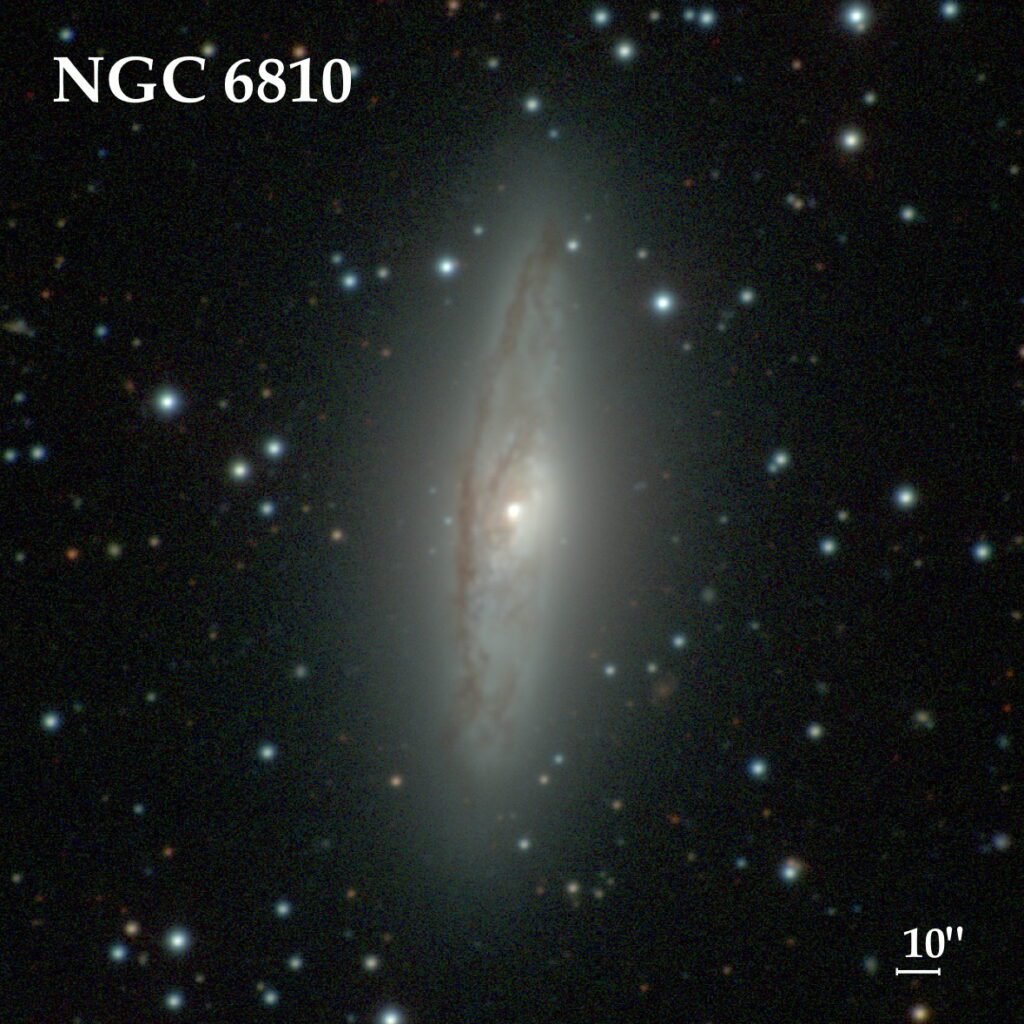
NGC 6872/IC 4970
NGC 6872
- Distance from earth -212 million light-years
- Size – 6.0′ × 1.7
- Magnitude – 10.69 (apparent)
- Type of galaxy – barred spiral galaxy
IC 4970
- Distance from the earth – 212 million light-years
- Size – 0.7′× 0.2′ (apparent)
- Magnitude – 13.06±0.09
- Type of galaxy: unbarred lenticular galaxy
A pair of interacting galaxies in Pavo is NGC 6872 (the Condor Galaxy) and IC 4970. They are about 220 million light years from the solar system and have apparent magnitudes of 12.7 and 14.7.
A class E7-S0 elliptical galaxy is IC 4970. The bigger of the two galaxies is NGC 6872, a spiral with an inherent sign form. There are several young blue stars in its spiral arm. It’s thought that IC 4970’s recent passage through the area was the reason for the starburst activity.
One of the largest, barred spiral galaxies is NGC 6872. It covers a distance of around 380,000 light years.
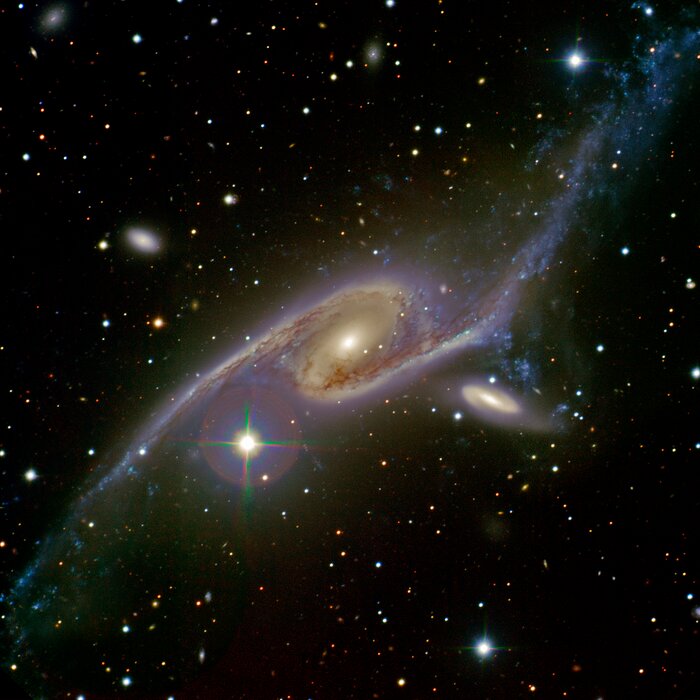
Star clusters
1. NGC 6752
2. 47 Tucanae
3. Omega Centauri
NGC 6752
- Distance from earth – 13,000 light-years
- Size -1.4×105 M☉
- Magnitude – 5.4 (apparent)
- Type of cluster – Globular
The NGC 6752 globular cluster, nicknamed the Great Peacock Globular, is located in the constellation Pavo and is best seen from June to October. It’s estimated to be 11.78 billion years old and is one of the closer globular clusters to our planet.
As far as brightness goes, it is the fourth brightest globular cluster in the sky, after Omega Centauri, 47 Tucanae, and Messier 22. So this is one of the star clusters that can be seen with the unaided eye.
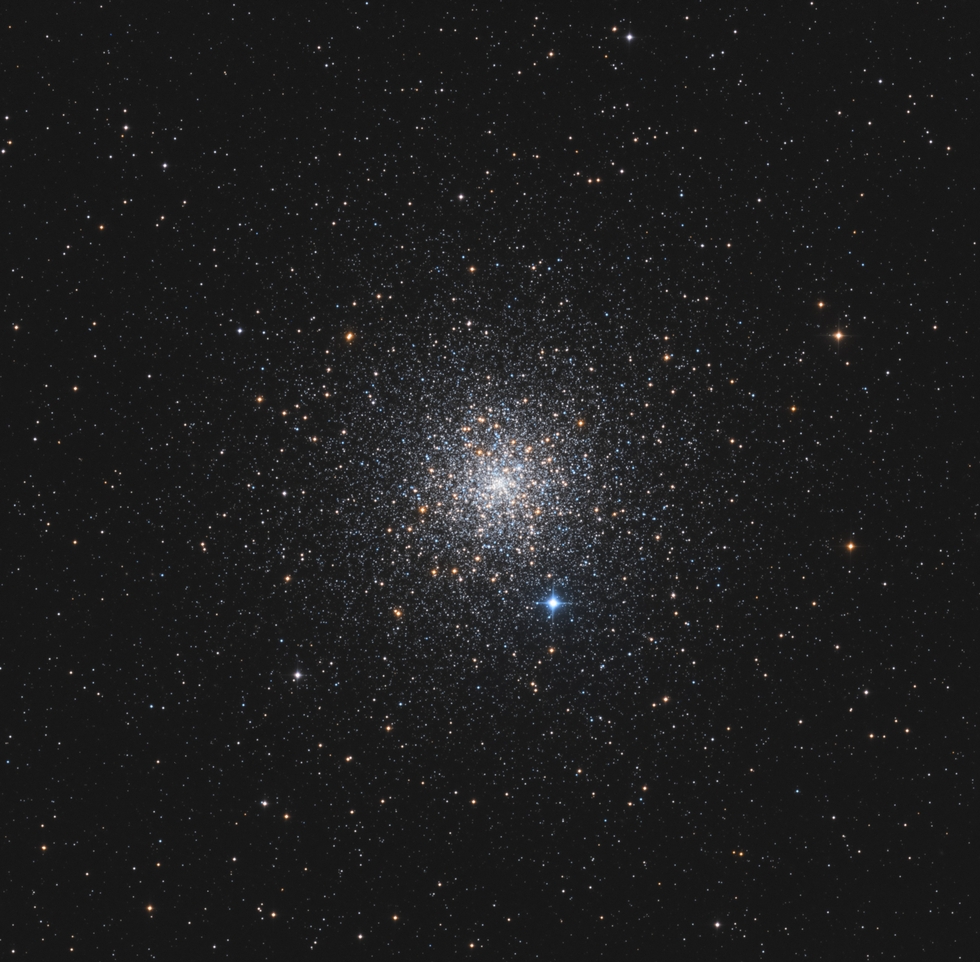
47 Tucanae
- Distance from earth -14,500 ± 32.6 light-years
- Size – 7.00×105 M☉
- Magnitude – +4.09 (apparent)
- Type of cluster – globular
47 Tucanae, which is the second-brightest globular cluster after Omega Centauri, displays roughly 10,000 stars contained within a small, dense central core. It’s such a dense core that people once thought it was the nucleus of a bright comet.
The core of the star cluster has also been the subject of a survey done by the Hubble Space Telescope. It was looking for planets but found none which suggested that planets may be relatively rare to find in globular clusters.
A black hole of intermediate mass may be present in the cluster although recent observations have not been able to verify that.
Either way, this approximately 13 billion year old star cluster, which occupies about as much space in the sky as the full moon, is impressive enough.
Omega Centauri
- Distance from earth – 17,090 light-years
- Size – (4.05±0.1)×106 M☉
- Magnitude – 3.9 (V)
- Type of cluster – globular
In stark contrast to the majority of other galactic globular clusters, Omega Centauri is said to have formed as the central relic of a dwarf galaxy that got destroyed. Ptolemy listed this object as a star on the back of a horse in his Almagest.

Meteors
The August Pavonids and the Delta Pavonids are two yearly meteor showers that originate from Pavo.
The Delta Pavonids can be seen from March 21st to April 8th and usually peak on April 5th and 6th.
They are likely to be connected to Comet Grigg-Mellish. Michael Buhagiar from Perth, Australia, spotted the shower between 1969 and 1980 on six occasions.
Closing thoughts
The stars of Pavo and the nearby constellation Ara were interpreted by the Wardaman people of Australia’s Northern Territory as flying foxes.
Pavo has many star clusters, galaxies, and intriguing mythologies that add credence to its already spectacular constellation.
For instance, IC 4687, IC 4689, and IC 4686 are a trio of interacting and blending galaxies in Pavo, around 250 million light-years far from the Solar System.
What’s amazing is that 47 Tucanae telescopically shows roughly 10,000 stars, and the cluster may house an intermediate-mass black hole. While Bedin I may be one of the oldest galaxies known since it formed around 10-13 billion years ago.
You must remember Pavo is not one of the twelve constellations that make up the Zodiac. If you are a sky watcher or star gazer, you will be glad to know many of Pavo’s stars can be seen with the naked eye.

